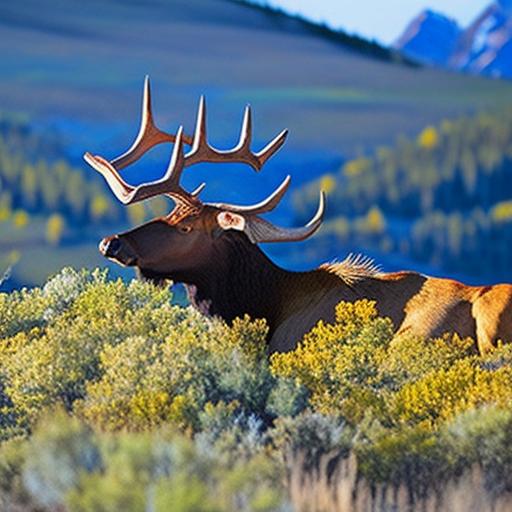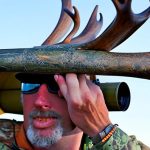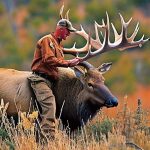Your cart is currently empty!

The Ultimate Guide to a Successful $750 Elk Hunt: Tips and Tricks for Bagging Your Trophy Bull

Elk hunting is a popular and challenging outdoor activity that attracts hunters from all over the world. Known for their size, strength, and elusive nature, elk provide a thrilling hunting experience for those who are up to the challenge. However, in order to be successful in hunting elk, it is crucial to have a deep understanding of their behavior and habits. By understanding elk behavior, hunters can increase their chances of a successful hunt and have a more enjoyable experience in the wilderness.
Key Takeaways
- Understanding elk behavior is crucial for successful hunting
- Essential gear for elk hunting includes proper clothing, a reliable firearm, and a good pair of binoculars
- When choosing a hunting spot, consider factors such as food sources, water, and cover
- Mastering elk calls is important for luring them in and mimicking their sounds
- Tracking elk requires knowledge of their habits and the ability to read signs such as tracks and droppings
- Stalking elk requires patience, stealth, and the ability to move quietly through the terrain
- Shot placement is critical for a clean kill and should aim for the heart or lungs
- Field dressing and processing your elk requires knowledge of anatomy and proper techniques
- The best time and place to go elk hunting depends on the season and location
- Hunting ethics involve respecting wildlife and the environment, including following regulations and leaving no trace.
Understanding Elk Behavior: A Key to Successful Hunting
Elk are highly intelligent animals with complex social structures and habits. They are known for their ability to adapt to different environments and their keen senses, which make them difficult to approach undetected. Understanding elk behavior is essential for hunters because it allows them to anticipate the movements and patterns of these majestic creatures.
Elk are most active during the early morning and late afternoon hours, known as the “golden hours.” During these times, they are more likely to be feeding or moving from one area to another. By studying their habits and patterns, hunters can determine the best times and locations to set up their hunting spots.
Essential Gear for Elk Hunting: What You Need to Pack
When embarking on an elk hunting trip, it is important to pack the right gear to ensure a safe and successful hunt. This includes appropriate clothing and footwear, hunting equipment, and survival gear.
Clothing should be chosen based on the weather conditions and terrain of the hunting area. Layering is key to staying warm and comfortable during long hours in the field. It is also important to invest in quality waterproof and insulated boots that provide support and traction.
In terms of hunting equipment, a high-powered rifle or bow is necessary for taking down an elk. Optics such as binoculars or a spotting scope are also essential for scouting and locating elk from a distance. Additionally, a backpack with essential survival gear such as a first aid kit, water purification tablets, and emergency food supplies should always be packed.
Choosing the Right Hunting Spot: Factors to Consider
| Factors to Consider | Description |
|---|---|
| Food and Water Availability | Animals need food and water to survive, so look for areas with abundant vegetation and water sources. |
| Animal Behavior | Learn about the behavior of the animal you are hunting, such as their feeding and mating patterns, to increase your chances of success. |
| Weather Conditions | Weather can affect animal behavior and movement, so consider factors such as temperature, wind, and precipitation when choosing a hunting spot. |
| Accessibility | Choose a hunting spot that is easily accessible and safe to reach, whether by foot or vehicle. |
| Legal Regulations | Make sure you are aware of the hunting regulations in your area, including hunting seasons, bag limits, and any restrictions on hunting methods or weapons. |
| Personal Experience | Consider your own hunting experience and knowledge of the area when choosing a hunting spot. |
Choosing the right hunting spot is crucial for a successful elk hunt. There are several factors to consider when selecting a location, including terrain and vegetation, water sources, and weather conditions.
Elk prefer areas with a mix of open meadows and dense forests. They often feed in meadows and graze on grasses and shrubs, but also seek cover in the forest for protection. By understanding their preferred habitat, hunters can narrow down potential hunting spots.
Water sources are also important to consider when choosing a hunting spot. Elk need to drink water daily, so locating areas with nearby streams or ponds can increase the chances of encountering elk.
Lastly, weather conditions play a significant role in elk behavior. Elk are more active during cooler temperatures and overcast days. They tend to bed down during hot weather or when there is heavy rain or snowfall. By monitoring weather forecasts and adjusting hunting plans accordingly, hunters can increase their chances of success.
Mastering Elk Calls: How to Mimic Their Sounds
Elk are highly vocal animals and use various calls to communicate with each other. Mastering elk calls is an essential skill for hunters as it allows them to attract elk and bring them closer for a shot.
There are several types of elk calls that hunters can use, including bugles, cow calls, and calf calls. Bugles are used by male elk during the rutting season to establish dominance and attract females. Cow calls mimic the sounds made by female elk and can be used to lure in bulls. Calf calls imitate the sounds made by young elk and can be effective in attracting protective cows.
To make realistic elk calls, hunters can use diaphragm calls, external reed calls, or electronic callers. It is important to practice and become familiar with the different calls to ensure accuracy and authenticity. By mimicking the sounds of elk, hunters can increase their chances of drawing them in closer for a shot.
Tracking Elk: Techniques for Following Their Trail

Tracking elk is an essential skill for hunters as it allows them to locate and follow the trail of these elusive animals. By identifying tracks and signs left by elk, hunters can determine their direction of travel and increase their chances of a successful hunt.
When tracking elk, it is important to look for fresh tracks and signs such as droppings, rubs on trees, and bedding areas. Fresh tracks will have distinct edges and may still be slightly damp. By following these signs, hunters can determine the general direction in which the elk are moving.
Different terrains require different tracking techniques. In open areas, it is easier to spot tracks and follow the trail. In dense forests or rocky terrain, it may be necessary to rely on other signs such as broken branches or disturbed vegetation. By adapting tracking techniques to the specific terrain, hunters can effectively follow the trail of elk.
Technology can also aid in tracking elk. GPS devices or smartphone apps can be used to mark and track the location of fresh tracks or sightings. This can be especially helpful when hunting in unfamiliar areas or when tracking over long distances.
Stalking Elk: Strategies for Getting Close
Stalking elk requires patience, stealth, and a deep understanding of their behavior. Elk have keen senses of smell, sight, and hearing, making them difficult to approach without being detected. However, with the right strategies and techniques, hunters can get close enough for a shot.
One strategy for stalking elk is to use cover and terrain to your advantage. By staying low and using natural features such as trees or rocks as concealment, hunters can move closer without being seen. It is important to move slowly and quietly, taking advantage of any available cover to break up your silhouette.
Another strategy is to use the wind to your advantage. Elk have a strong sense of smell and can detect human scent from a distance. By staying downwind of the elk, hunters can minimize the chances of being detected. It is important to constantly monitor wind direction and adjust your approach accordingly.
Patience and persistence are key when stalking elk. It may take several attempts and hours of waiting to get within shooting range. It is important to remain calm and focused, taking your time to make a well-placed shot.
Shot Placement: Where to Aim for a Clean Kill
Shot placement is crucial for a quick and humane kill when hunting elk. By understanding the anatomy of an elk and knowing where to aim, hunters can increase their chances of a clean kill.
The vital organs of an elk are located in the chest cavity, behind the shoulder. The ideal shot placement is in the heart and lungs area, which will cause rapid blood loss and lead to a quick death. It is important to aim for the center of the chest, slightly behind the shoulder.
Accuracy and precision are essential when taking a shot at an elk. Hunters should practice shooting from different positions and distances to ensure they are comfortable and confident in their abilities. It is also important to use appropriate ammunition that is capable of penetrating the thick hide and muscle of an elk.
Field Dressing and Processing Your Elk: Step-by-Step Guide
After a successful hunt, it is important to properly field dress and process your elk to ensure the meat stays fresh and safe for consumption. Field dressing involves removing the internal organs from the carcass, while processing involves cutting the meat into manageable pieces.
To field dress an elk, you will need a sharp knife, gloves, and a game bag or tarp to lay the carcass on. Start by making an incision from the base of the sternum to the anus, being careful not to puncture any organs. Carefully remove the internal organs, taking care to avoid contamination of the meat.
Once the elk is field dressed, it is important to cool the meat as quickly as possible. This can be done by hanging the carcass in a cool, shaded area or by placing ice packs or bags of ice inside the body cavity. After the meat has cooled, it can be processed into steaks, roasts, and ground meat.
Planning Your Elk Hunt: Best Time and Place to Go
When planning an elk hunt, it is important to consider seasonal factors and choose the right location. Elk hunting seasons vary depending on the state and region, so it is important to check local regulations and obtain the necessary permits.
The best time to hunt elk is during their rutting season, which typically occurs in the fall. During this time, bulls are more active and vocal as they compete for mates. It is also important to consider weather conditions, as elk are more active during cooler temperatures.
Choosing the right location for an elk hunt depends on several factors. It is important to research areas with healthy elk populations and suitable habitat. National forests, state parks, and private land leases are common options for elk hunting. It is also important to consider accessibility and proximity to amenities such as lodging and food.
Hunting Ethics: Respecting Wildlife and the Environment
Hunting ethics play a crucial role in ensuring the sustainability of wildlife populations and preserving natural habitats. It is important for hunters to practice ethical hunting practices and respect wildlife and the environment.
One of the key principles of ethical hunting is fair chase. Fair chase means giving animals a reasonable chance to escape and using hunting methods that do not give hunters an unfair advantage. This includes following hunting regulations, using legal equipment, and respecting property boundaries.
Another important principle is practicing leave no trace principles. This means minimizing your impact on the environment by packing out all trash, avoiding unnecessary damage to vegetation, and respecting wildlife habitats. It is important to leave the wilderness as you found it, or even better.
Conservation efforts are also an important aspect of hunting ethics. Hunters contribute to wildlife conservation through the purchase of hunting licenses and tags, which fund habitat restoration and management programs. It is important to support and participate in conservation efforts to ensure the long-term sustainability of elk populations and their habitats.
Elk hunting is a challenging and rewarding outdoor activity that requires a deep understanding of elk behavior, proper gear, and ethical hunting practices. By studying elk habits and patterns, hunters can increase their chances of a successful hunt. Packing the right gear, choosing the right hunting spot, mastering elk calls, tracking elk, stalking effectively, and practicing shot placement are all essential skills for a successful hunt. It is also important to practice ethical hunting practices and respect wildlife and the environment. With proper preparation and a responsible approach, elk hunting can be a thrilling and memorable experience in the wilderness.
If you’re interested in hunting and looking for more tips and advice, check out the article on “How to Hunt Pheasant” from Old Oak Syndicate. Pheasant hunting can be an exciting and challenging experience, and this article provides valuable insights on the best techniques, gear, and strategies to make your hunt successful. Whether you’re a seasoned hunter or just starting out, this article is a must-read for anyone looking to improve their pheasant hunting skills. Read more
FAQs
What is the $750 elk hunt?
The $750 elk hunt is a guided hunting trip for elk in a specific location, typically in the United States.
What is included in the $750 elk hunt?
The specifics of what is included in the $750 elk hunt can vary depending on the provider, but typically it includes a guided hunting trip, lodging, and meals.
What is not included in the $750 elk hunt?
Again, this can vary depending on the provider, but typically transportation to and from the hunting location, hunting licenses and tags, and any necessary equipment or gear are not included in the $750 elk hunt.
What is the success rate of the $750 elk hunt?
The success rate of the $750 elk hunt can vary depending on a number of factors, including the skill of the hunter, the location, and the time of year. It is important to research the provider and location before booking to get an idea of the success rate.
What is the hunting season for elk?
The hunting season for elk can vary depending on the location and the type of elk being hunted. Generally, the season runs from late summer to early winter.
What kind of equipment do I need for the $750 elk hunt?
Again, this can vary depending on the provider and location, but typically hunters will need a rifle or bow, appropriate clothing and footwear, and any necessary camping or hunting gear. It is important to check with the provider for specific equipment requirements.

Herb has been a longtime lover of the outdoors. Whether it be hunting, camping, fishing or just getting outside to reset. Proud father and animal lover. Bourbon anyone?

by
Tags:
Comments

Categories
- Big Game Hunting (301)
- Deer (202)
- Reviews (3)
- Shooting (16)
- Slingshot (1)
- Small Game Hunting (42)
- Upland Hunting (126)
- Waterfowl Hunting (3)





Leave a Reply